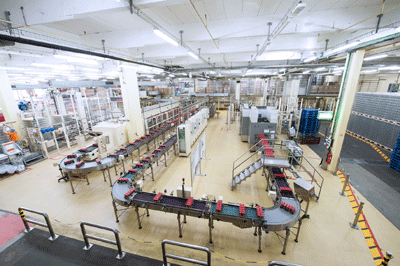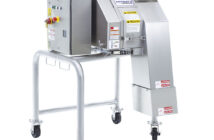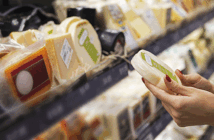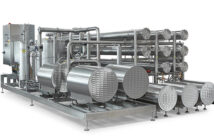Under the project name of ‘Ergos’, Nestlé has so far carried out a product relaunch for its Nescafé Gold instant coffee at six international facilities in Europe and Australia, featuring a new shape of jar and sophisticated dress.
Nestlé has had seven Krones Topmodule labellers installed for this purpose. At its German facility in Mainz, Nestlé went one step further. Here, for the first time, the world’s market leader in the instant coffee segment placed a turnkey order for designing a complete coffee filling and packaging line with a single vendor. Krones had to combine new machines with existing units and outsourced third-party kit to optimum effect in order to create a complete line operating at maximised efficiency.
Nestlé Deutschland AG’s plant at Mainz on the River Rhine produces the Nescafé brand, plus cocoa based drinks like Nesquik and Nestlé Finest Hot Chocolate, with 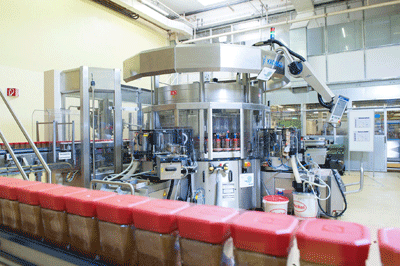
The goal of Nestlé’s Ergos project was to set a new standard of labelling excellence for a glass package of instant coffee, designed to stand out distinctively from its competitors on the supermarket shelves. In very close and 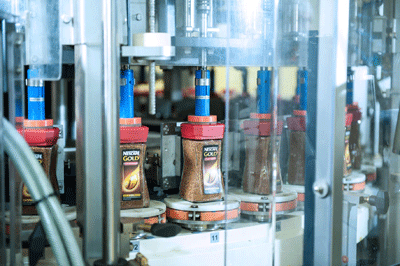
This configuration was to be the same for all facilities in which the new Ergos concept for Nescafé Gold had been earmarked for implementation, which included 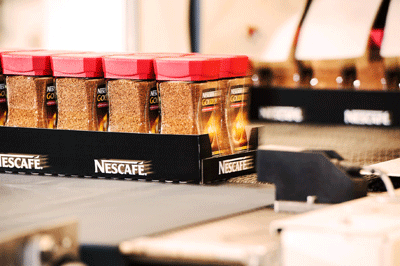
As the turnkey vendor involved, Krones’ task was to coordinate existing machinery with its own new machines and kit from other vendors. An existing fulls inspector had been earmarked for continued use, as were a linear air rinser, induction sealing units and a pallet wrapper. Krones integrated a filler from the Optima company, which specialises in powder filling, and a closer from Zalkin. The remaining kit supplied by Krones was manufactured in-house.
“Our lines are usually given a U-shaped layout,” says Bernhard Rau, foreman in the filling and packaging hall.
“The containers are passed from the dry end to the separate filling zone, and back into the packaging segment.”
The pallets of bulk glass are fed in, and the fi lm is removed, after which a Krones’ Pressant bulk glass sweep-off depalletiser moves them layer by layer onto a mass conveyor. After they have been spaced out and turned upside down, they are blown out with dry air in a linear glass cleaner. The containers are now passed to the separate hygiene zone, where the coffee powder, after having being fed into an overhead funnel, descends by gravity to a rotary volumetric filler with 32 filling valves, which fills the actual jars. As the reference machine, the filler runs at 320 jars a minute for 50 and 100 gram containers, and at 280 jars a minute for 200 gram jars. To ensure aroma retention, the jars are then sealed with a membrane and closed with a turning lid.
A newly created Accutable buffering section provides up to two minutes of buffering time for the downstream machines. First of all, a fulls inspector monitors the closed containers for foreign bodies, using x-rays. The jars are then dressed on the Topmodule labeller, beginning with an Autocol station, which applies pressure-sensitive labels to the lid, followed by two cold-glue stations for the front and back labels, and another pressure- sensitive labelling station for stickers on the side of the lid.
Two Checkmat cameras then inspect the precise label position and monitor the presence of front and back labels, by running a comparison routine with defined points on the container. Nestlé attached particular importance to this rechecking of the label position and verification by the Checkmat.
“This Checkmat is a very good invention,” says Michael Stryszyk, who since early 2012 has been the manager responsible for the packaging operations in the filying and packaging hall.
“We can rely on an exceptionally low error rate in the per-thousandth range, because the Checkmat is very dependable in operation. At first we had a few concerns that it might react over-sensitively, but now we’re getting really good results from it.”
Incorrectly labelled containers are rejected – they total about one percent, and are essentially attributable to the print quality of the labels concerned.
The containers now leave the hygiene area and are passed back to the dry end, with a jar line distributor allocating them among up to six lanes as the indeed flow to the Variopac Pro packer. The tray packer produces half-depth trays with downstream fi lm-wrapping in a hot-air shrink tunnel or full-depth trays without fi lm. Depending on the size of the jar concerned, packs are created here holding two times three, three times four or two times five jars. Over the course of a downstream buffering section, the trays are turned, self-adhesive labels are affixed to the film showing the best-before date, and then the trays are turned again. The palletising layers are formed by a Robobox pack grouping unit. The layers are fed to a Modulpal palletiser, which creates the stacks, while layer pads are inserted to stabilise them. The completed pallet of fulls is then wrapped to secure it for transportation. The entire line is monitored by a Krones’ line diagnostic system. Production operations can additionally be supported by an order management system.
“The installation phase was very well supported by Krones,” says Bernhard Rau.
“Everything went according to plan.”
Acceptance- testing took place at the end of May 2011, and the handing-over criteria agreed were more than met, with an efficiency of 96.7 percent for Krones’ own scope of delivery and 93.1 per cent for the line as a whole.
“It’s important to us that the entire line runs with maximised stability”, emphasises Michael Stryszyk.
“Placing this order as a turnkey job was definitely the right decision.”


























































































